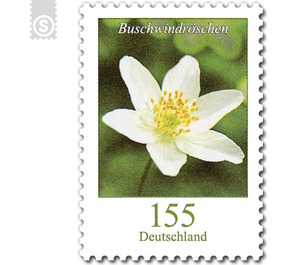Definitive Series "Flowers" - Wood Anemone, self-adhesive - Germany / Federal Republic of Germany 2019 - 155 Euro Cent
Theme: Flora
| Country | Germany / Federal Republic of Germany |
| Issue Date | 2019 |
| Face Value | 155.00 |
| Color | green white |
| Printing Type | Multicolor offset printing |
| Stamp Type | Definitive |
| Item Type | Stamp |
| SID | 247749 |
| Dimensions | 22.00 x 30.00 |
| In 71 Wishlists | |
The Wood anemone (Anemone nemorosa) is native to the ranunculaceae family (Ranunculaceae). It grows in the temperate zones of Europe and Asia in forests and forest edges, but also feels good as groundcover and planting in the garden. In ancient times, the wood anemone was considered a medicinal plant. Like all buttercup plants, it contains protoanemonin, which is poisonous to animals and humans. Because of their toxicity, cock foot plants were formerly used for the production of arrow poison. The botanical first description of the Anemone nemorosa was made in 1753 by Carl Linnaeus. The wood anemone has countless, very different and often only locally common trivial names, which refer mostly to their white flower ("Käsblümli" and "Quarkblume") and their Frühblüher property ("Schneekaterl" and "Easter flower"). The science explains: Because the fine petals in the smallest wind (Greek "anemos") move and the wood anemone in shady, wooded (lat. "Nemorosa") places grows, it is called Anemone nemorosa.


